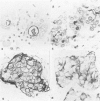Abstract
The monoclonal antibodies HMFG1 and HMFG2 identify antigens of the milk fat globule membrane which are also found on breast epithelial cells. Immunohistochemical staining was performed using both antibodies on formalin fixed, paraffin embedded sections of 93 breast carcinoma, 36 histologically benign lesions and 29 histologically normal breast tissue blocks. In both normal and benign breast disease the staining was largely extracellular whilst in malignant tissue the staining was variable and often intracellular. Nine carcinomas did not stain with either antibody. The staining patterns of malignant tissues were graded and no correlation was found between the grades and survival or indices of prognosis, (the oestrogen receptor status, Bloom's grade and the presence or absence of metastases to the axillary nodes.) This study indicates that with the present methods available for grading staining patterns, although of diagnostic value, these monoclonal antibodies are unlikely to assist in determining either the degree of tumour differentiation or prognosis in breast carcinoma.
Full text
PDF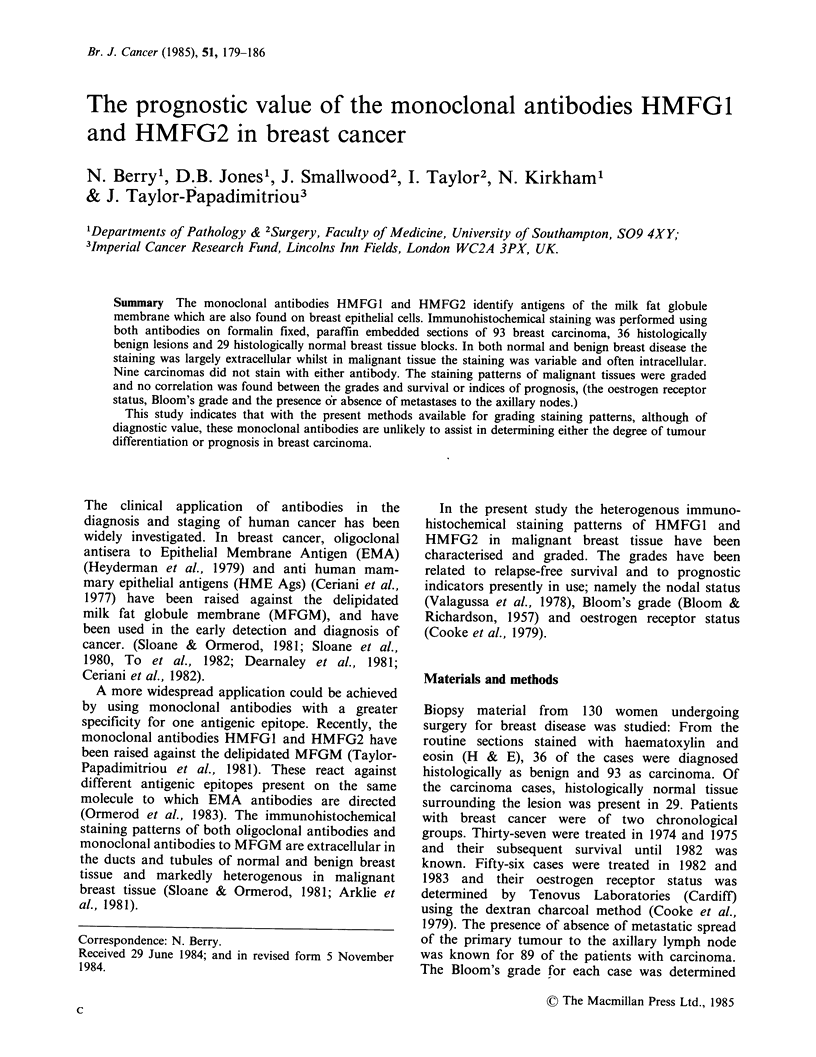
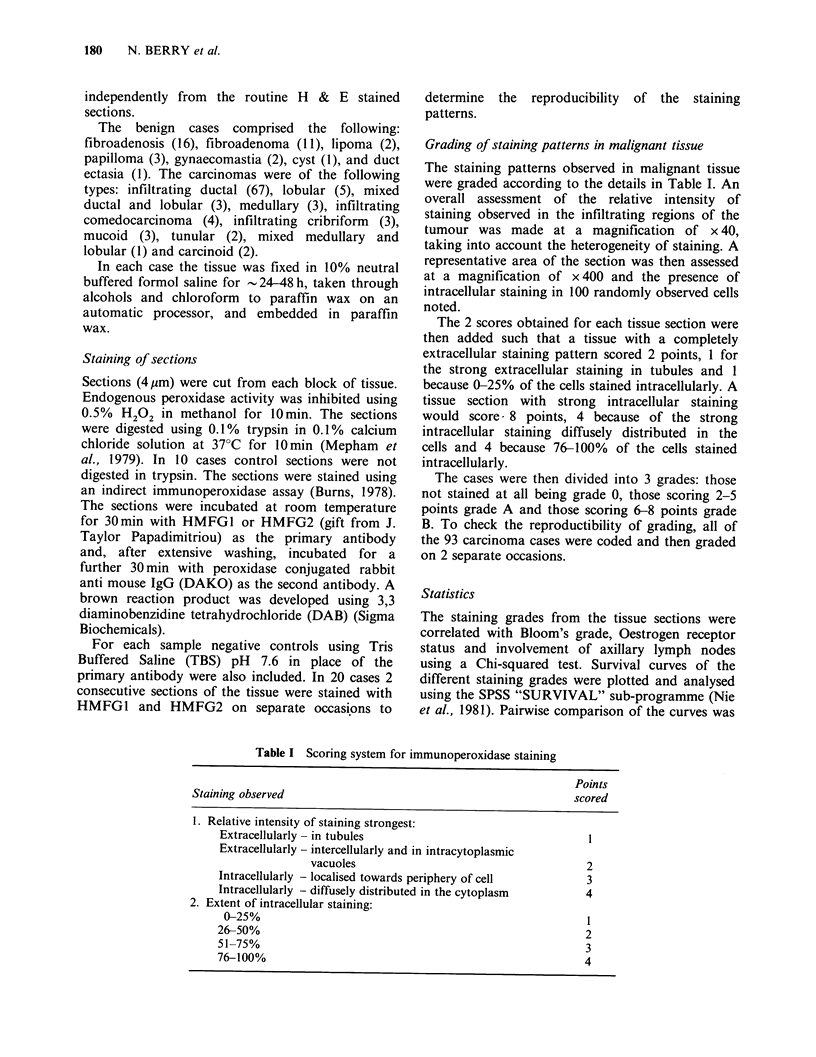
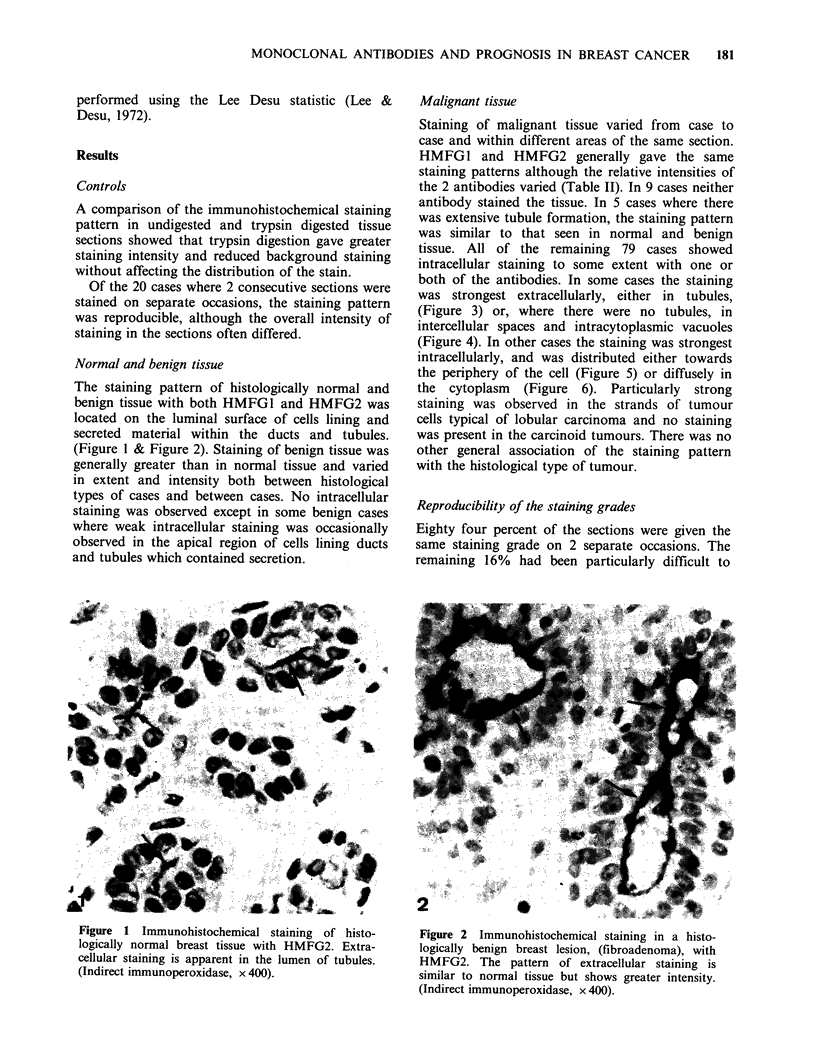
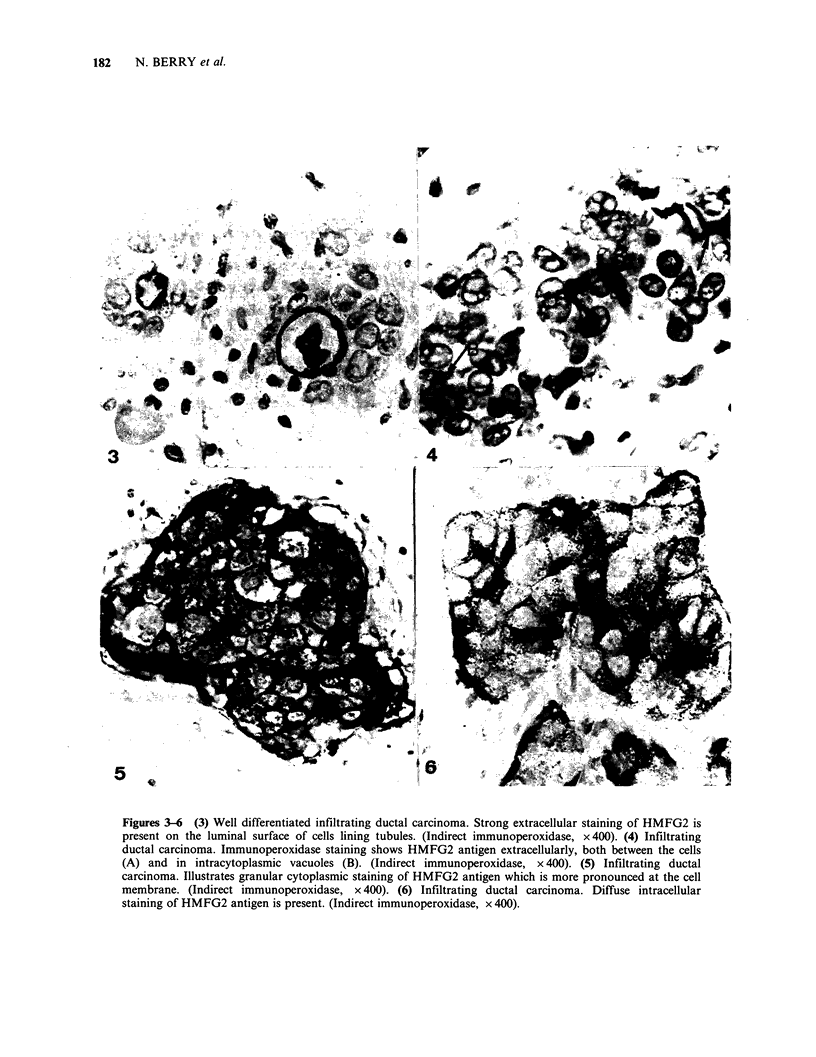
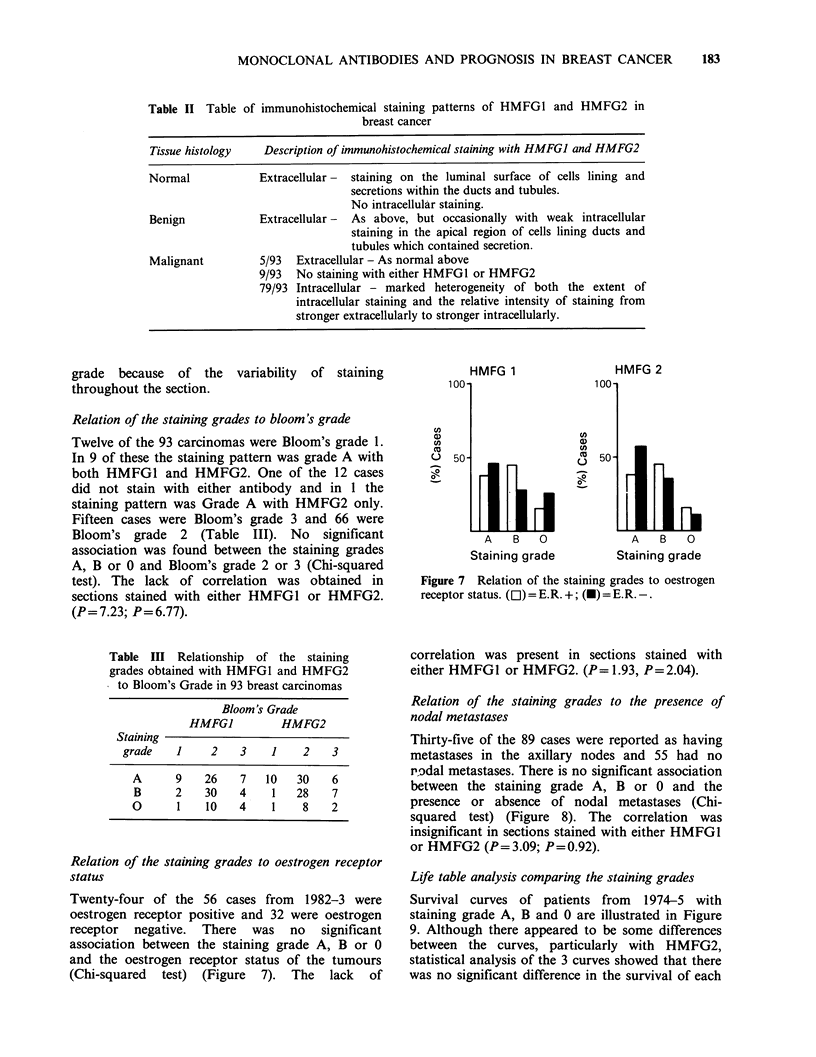
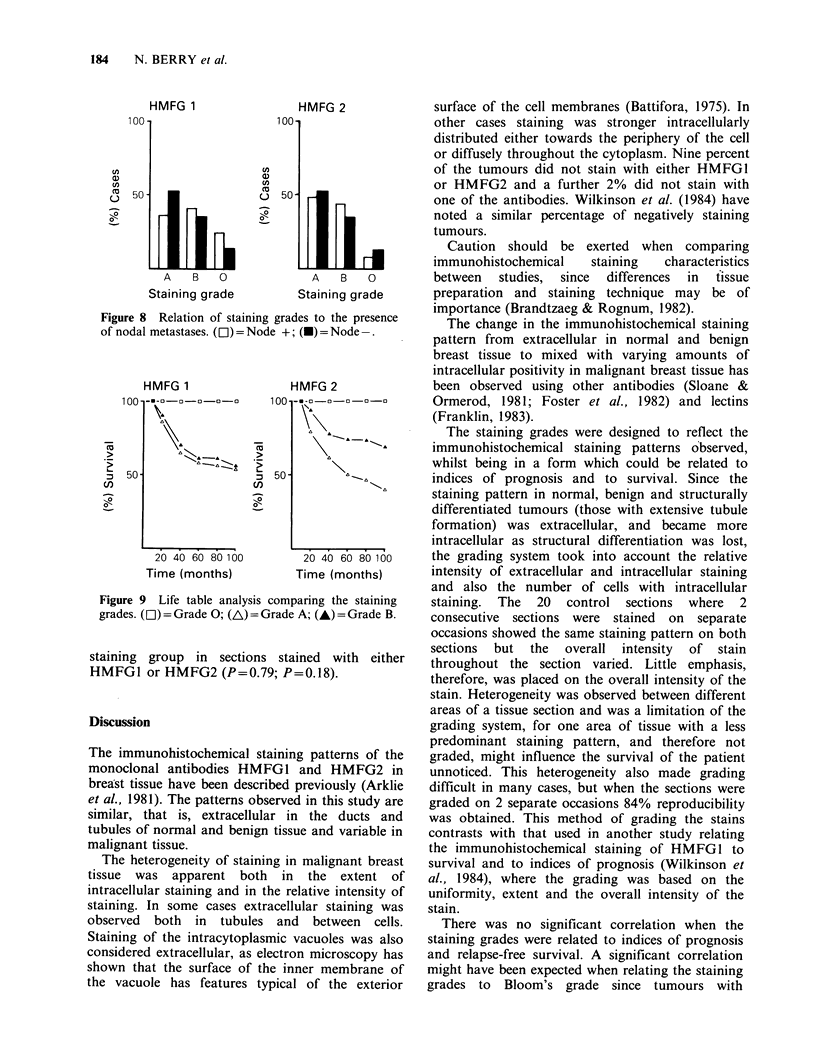
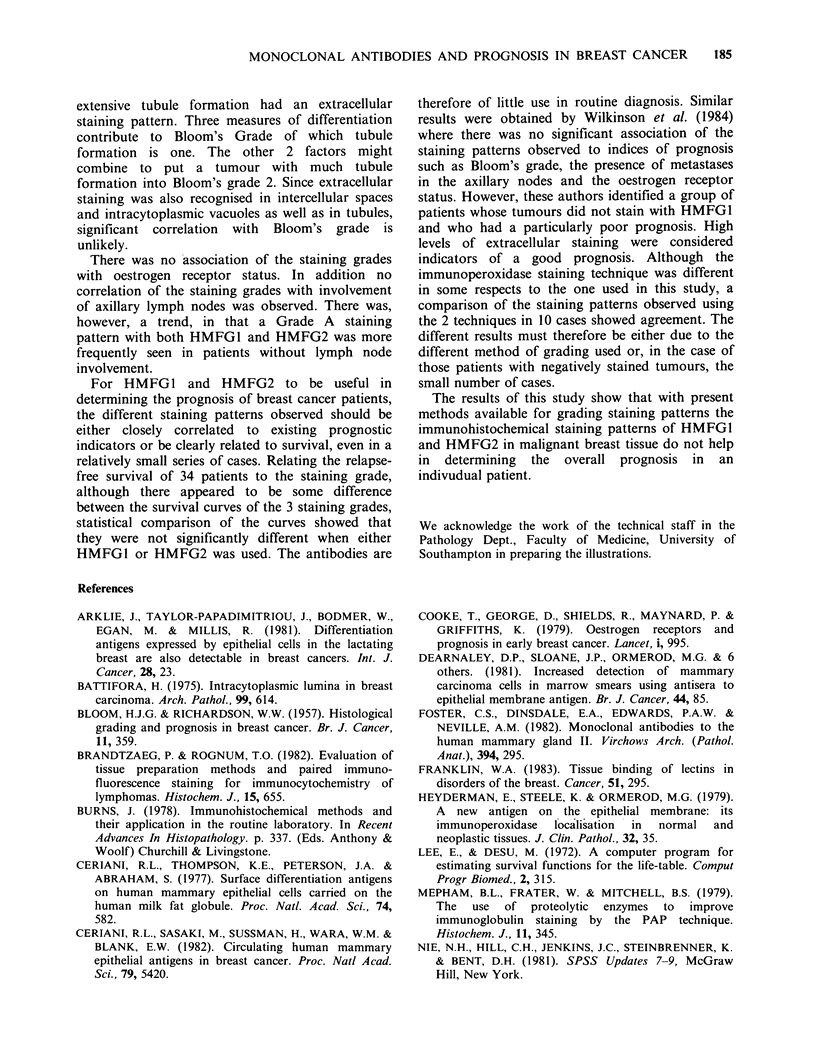

Images in this article
Selected References
These references are in PubMed. This may not be the complete list of references from this article.
- Arklie J., Taylor-Papadimitrious J., Bodmer W., Egan M., Millis R. Differentiation antigens expressed by epithelial cells in the lactating breast are also detectable in breast cancers. Int J Cancer. 1981 Jul 15;28(1):23–29. doi: 10.1002/ijc.2910280105. [DOI] [PubMed] [Google Scholar]
- BLOOM H. J., RICHARDSON W. W. Histological grading and prognosis in breast cancer; a study of 1409 cases of which 359 have been followed for 15 years. Br J Cancer. 1957 Sep;11(3):359–377. doi: 10.1038/bjc.1957.43. [DOI] [PMC free article] [PubMed] [Google Scholar]
- Battifora H. Intracytoplasmic lumina in breast carcinoma: a helpful histopathologic feature. Arch Pathol. 1975 Nov;99(11):614–617. [PubMed] [Google Scholar]
- Brandtzaeg P., Rognum T. O. Evaluation of tissue preparation methods and paired immunofluorescence staining for immunocytochemistry of lymphomas. Histochem J. 1983 Jul;15(7):655–689. doi: 10.1007/BF01002987. [DOI] [PubMed] [Google Scholar]
- Ceriani R. L., Sasaki M., Sussman H., Wara W. M., Blank E. W. Circulating human mammary epithelial antigens in breast cancer. Proc Natl Acad Sci U S A. 1982 Sep;79(17):5420–5424. doi: 10.1073/pnas.79.17.5420. [DOI] [PMC free article] [PubMed] [Google Scholar]
- Ceriani R. L., Thompson K., Peterson J. A., Abraham S. Surface differentiation antigens of human mammary epithelial cells carried on the human milk fat globule. Proc Natl Acad Sci U S A. 1977 Feb;74(2):582–586. doi: 10.1073/pnas.74.2.582. [DOI] [PMC free article] [PubMed] [Google Scholar]
- Cooke T., George D., Shields R., Maynard P., Griffiths K. Oestrogen receptors and prognosis in early breast cancer. Lancet. 1979 May 12;1(8124):995–997. doi: 10.1016/s0140-6736(79)92752-1. [DOI] [PubMed] [Google Scholar]
- Foster C. S., Dinsdale E. A., Edwards P. A., Neville A. M. Monoclonal antibodies to the human mammary gland. II. Distribution of determinants in breast carcinomas. Virchows Arch A Pathol Anat Histol. 1982;394(3):295–305. doi: 10.1007/BF00430672. [DOI] [PubMed] [Google Scholar]
- Franklin W. A. Tissue binding of lectins in disorders of the breast. Cancer. 1983 Jan 15;51(2):295–300. doi: 10.1002/1097-0142(19830115)51:2<295::aid-cncr2820510222>3.0.co;2-t. [DOI] [PubMed] [Google Scholar]
- Heyderman E., Steele K., Ormerod M. G. A new antigen on the epithelial membrane: its immunoperoxidase localisation in normal and neoplastic tissue. J Clin Pathol. 1979 Jan;32(1):35–39. doi: 10.1136/jcp.32.1.35. [DOI] [PMC free article] [PubMed] [Google Scholar]
- Lee E. T., Desu M. M. A computer program for comparing K samples with right-censored data. Comput Programs Biomed. 1972 Nov;2(4):315–321. doi: 10.1016/0010-468x(72)90019-0. [DOI] [PubMed] [Google Scholar]
- Mepham B. L., Frater W., Mitchell B. S. The use of proteolytic enzymes to improve immunoglobulin staining by the PAP technique. Histochem J. 1979 May;11(3):345–357. doi: 10.1007/BF01005033. [DOI] [PubMed] [Google Scholar]
- Sloane J. P., Ormerod M. G. Distribution of epithelial membrane antigen in normal and neoplastic tissues and it value in diagnostic tumor pathology. Cancer. 1981 Apr 1;47(7):1786–1795. doi: 10.1002/1097-0142(19810401)47:7<1786::aid-cncr2820470711>3.0.co;2-8. [DOI] [PubMed] [Google Scholar]
- Sloane J. P., Ormerod M. G., Imrie S. F., Coombes R. C. The use of antisera to epithelial membrane antigen in detecting micrometastases in histological sections. Br J Cancer. 1980 Sep;42(3):392–398. doi: 10.1038/bjc.1980.250. [DOI] [PMC free article] [PubMed] [Google Scholar]
- Taylor-Papadimitriou J., Peterson J. A., Arklie J., Burchell J., Ceriani R. L., Bodmer W. F. Monoclonal antibodies to epithelium-specific components of the human milk fat globule membrane: production and reaction with cells in culture. Int J Cancer. 1981 Jul 15;28(1):17–21. doi: 10.1002/ijc.2910280104. [DOI] [PubMed] [Google Scholar]
- To A., Dearnaley D. P., Ormerod M. G., Canti G., Coleman D. V. Epithelial Membrane Antigen. Its use in the cytodiagnosis of malignancy in serous effusions. Am J Clin Pathol. 1982 Aug;78(2):214–219. doi: 10.1093/ajcp/78.2.214. [DOI] [PubMed] [Google Scholar]
- Valagussa P., Bonadonna G., Veronesi U. Patterns of relapse and survival in operable breast carcinoma with positive and negative axillary nodes. Tumori. 1978 Jun 30;64(3):241–258. doi: 10.1177/030089167806400302. [DOI] [PubMed] [Google Scholar]
- Wilkinson M. J., Howell A., Harris M., Taylor-Papadimitriou J., Swindell R., Sellwood R. A. The prognostic significance of two epithelial membrane antigens expressed by human mammary carcinomas. Int J Cancer. 1984 Mar 15;33(3):299–304. doi: 10.1002/ijc.2910330304. [DOI] [PubMed] [Google Scholar]





